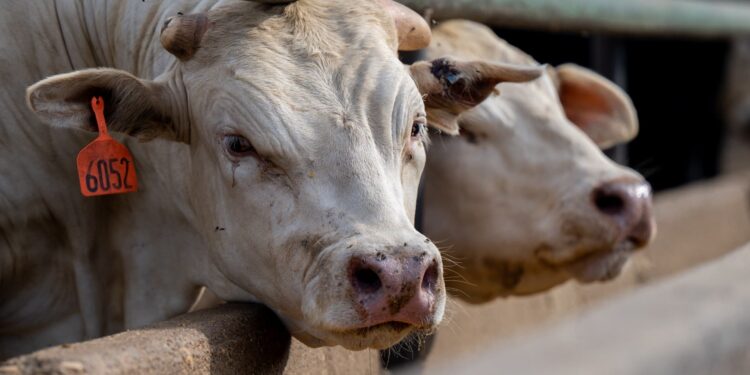A picture of cows in a feedlot taken on June 14, 2023, in Quemado, Texas.
Photo by Brandon Bell | Getty Images
American health officials are keeping a close eye on and preparing for a possible outbreak of bird flu in humans, while stressing that the risk to the general population is still low.Â
A variant of bird flu known as H5N1 has been discovered in dairy cows in nine U.S. states as well as in two individuals, amidst a worldwide outbreak among poultry and other animals. The most recent case was reported on Wednesday in a dairy farm worker in Michigan. Additionally, a child in Australia was recently diagnosed with bird flu, as announced by the country on Tuesday.
While H5N1 has been spreading among various animal species around the world since 2020, its appearance in U.S. livestock earlier this year was an unexpected development for health officials. In rare instances, bird flu viruses can be transmitted to humans, resulting in symptoms ranging from mild to severe that may necessitate hospitalization.Â
At present, there is no evidence to suggest that H5N1 can be transmitted from human to human. The Centers for Disease Control and Prevention (CDC) has also indicated that farmworkers are at a greater risk of infection than the general public.Â
Nevertheless, the U.S. government, in conjunction with state and local health departments, is keeping a close watch on new and emerging infections in both humans and animals. Federal agencies in the U.S. and abroad have also been monitoring the H5N1 virus for years to track its evolution.Â
For a long time, the U.S. government has been storing vaccines and medications for use in a potential bird flu pandemic. Last week, it began preparing approximately 5 million doses of vaccines believed to be effective against H5N1, among other response efforts, as confirmed by the Health and Human Services Department to CNBC.Â
Several infectious disease specialists informed CNBC that the U.S. government seems to be generally ready if bird flu starts to spread more widely and easily to humans, particularly in comparison with the country’s preparedness for the Covid pandemic. The experts noted that most of the necessary tools are already available, but the government needs to ensure they are deployed effectively if needed.Â
Dr. Andrew Pekosz, a professor at the Johns Hopkins Bloomberg School of Public Health, asserted, “There are many components already in place that give us confidence that we can respond to this more rapidly. The crucial thing, as always, is the effectiveness of our responses. We know what we can do, we just need to do it effectively.”
The recent human infection in the Michigan dairy worker was not unexpected, according to both experts and the government. The CDC announced on Wednesday that similar cases in humans might be identified due to high levels of the virus in raw milk from infected cows.
Millions of vaccine doses
The U.S. government currently has two virus candidates for a vaccine that it believes could be effective against H5N1. These candidates are weakened forms of a virus that trigger a protective immune response against it in the body and can be used to produce vaccines.
Both candidates are already available to manufacturers, according to the CDC. Last week, the government initiated the manufacturing process of 4.8 million doses of these human vaccines in case they are needed, as confirmed by HHS.Â
Pekosz termed these doses a “first line of defense in case we do see some human-to-human transmission.” He stated that this number is sufficient to curb an outbreak in its early stages, which could include vaccinating farm workers and some health-care workers.Â
However, he pointed out that many more vaccines would be needed for the over 300 million people in the U.S. if the virus spreads widely among humans.Â
Pekosz commented, “Five million doesn’t really get us very far. It’s just a quick start.”Â
On May 1, U.S. health officials stated that the government could distribute more than 100 million doses of human bird flu vaccines within three to four months if necessary, as reported by NBC News.Â
It’s worth noting that people will require two doses of a vaccine, which means that 100 million doses would be enough for only 50 million people. This suggests that the U.S. would need around 600 million shots if it wanted to vaccinate the entire population.Â
The government is faced with a tough decision regarding the number of shots to prepare, especially considering it takes a few months to produce them.
Dr. Peter Chin-Hong, an infectious disease physician at UCSF Health, said, “It’s either too little or too much. For instance, if you prepare too much food, then a lot of food goes to waste.” He added, “That’s really the main dilemma now with a vaccine whenever you have a potential threat. It’s the high cost and high-risk aspects.”
Chin-Hong pointed out that misinformation and vaccine hesitancy following Covid make the decision even more complicated. Yet, he expressed his belief that “you can never really invest too much” in pandemic preparedness, especially in a time when climate change, population growth, and other factors make pandemics increasingly likely to occur.
The Food and Drug Administration would need to approve bird flu vaccines before they can be distributed. However, Pekosz stated that this is likely to be a “rapid procedure” as the FDA is used to approving seasonal flu vaccines, which are produced using the same manufacturing process as bird flu vaccines.Â
Potential mRNA shots
U.S. health officials are also discussing the possibility of bird flu vaccines for humans with messenger RNA vaccine manufacturers. Not many details have been shared about these discussions, but HHS stated that a final announcement is anticipated soon.Â
Unlike traditional flu vaccines, mRNA instructs cells to produce a harmless piece of a virus, thereby triggering an immune response against certain diseases. This is the same technology used by both Pfizer and Moderna in their Covid vaccines.Â
Chin-Hong noted that mRNA vaccines can be updated more quickly to match the currently circulating strains of bird flu. However, he pointed out that they have their own challenges, such as the requirement for extremely cold storage temperatures.
In a statement to CNBC, Moderna confirmed its involvement in the government’s discussions regarding its experimental pandemic influenza vaccine, mRNA-1018, which targets the exact strain of the virus responsible for the outbreak in dairy cattle.Â
The biotech company initiated testing of this vaccine in an early- to mid-stage trial last summer.
Pfizer declined to confirm its involvement in the government’s discussions. The company stated it is continuing to monitor the spread of H5N1 and study its mRNA-based pandemic influenza vaccine candidates in an early trial.Â
Virus surveillance and treatments
The CDC and its partners, including state and local health departments, use various surveillance systems to monitor seasonal influenza and other illnesses. They also have specialized methods to detect and monitor new flu viruses.Â
Seasonal influenza predominantly spreads among humans with predictable peaks during the year, while bird flu primarily spreads among wild birds and other animals.
The CDC is looking for evidence of the spread of H5N1 to or among people in areas where the virus has been identified in animals or humans. So far, the agency has found “no indicators of unusual influenza activity in people,” including H5N1, according to an update on the agency’s site from last week.Â
The CDC also conducts ongoing analyses of seasonal and new influenza viruses to identify genetic changes that might allow them to cause more severe infections in humans, spread more easily to and between people, or become less susceptible to vaccines and medications.
Despite the extensive testing at the federal, state, and local levels, it is far more challenging for an average person to self-screen and get diagnosed for bird flu as they can for Covid, according to Chin-Hong. This is “the major obstacle, particularly in the populations that are getting affected now,” he said.
Chin-Hong is referring to farm workers, a large proportion of whom are immigrants, who may encounter difficulties navigating the U.S. health system due to language barriers and access to health care.Â
If individuals do contract the virus, there are a few FDA-approved antiviral medications for seasonal flu that can be used for bird flu. This includes Tamiflu, an oral prescription medication that should be taken within 48 hours of experiencing symptoms.Â
A dairy farm worker in Texas who was diagnosed with bird flu in March was treated with an antiviral medication and recovered, according to a CDC report.
However, Pekosz stated that the antiviral medications in the nation’s stockpile are likely insufficient for the vast majority of the population, so manufacturers may be asked to increase supply.
Francesca Torriani, an infectious disease specialist with UC San Diego Health, advises the average person to protect themselves from bird flu by avoiding any living or dead animals that might be infected, such as livestock or chickens.
Individuals who need to interact with these animals should wear the appropriate mask and eye protection and wash their hands afterward.
Torriani also suggested that pasteurized milk and cheese are likely safer to consume than raw dairy products since the pasteurization process destroys harmful bacteria.






















